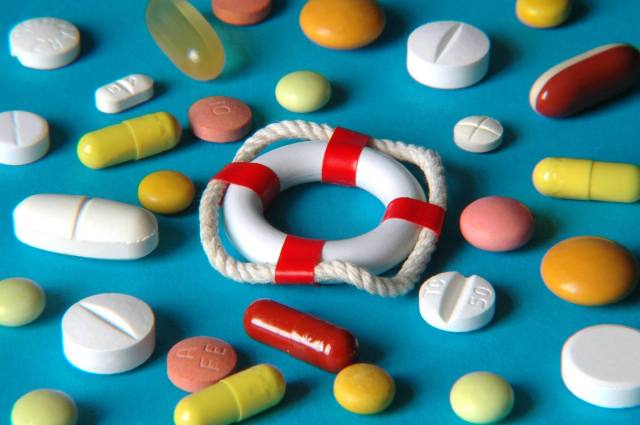Illustration – Various colorful tablets and capsules are spread around a miniature safety buoy, in Berlin, Germany, 25 December 2007. Photo: Berliner Verlag/S.Steinach

Across the western world the long-term rate of economic growth is slowing down. This is the fundamental fact at the heart of all our economic woes – from government indebtedness to stagnating wages.
Economic growth is ultimately a function of productivity improvement, which is in turn nourished by innovation. But what does innovation depend upon?
In part, it’s the freedom that brilliant people have to pursue new ideas – and their profitable application. By enabling the inventors and entrepreneurs to keep pushing at the limits of the possible, economic growth can be sustained indefinitely.
Or at least that’s the theory. In reality, the potential of innovation can become exhausted – not just by complacency, bureaucracy or some other human failing, but by reality itself. Consider Moore’s Law which is the observation/prediction that advances in chip design allow computer processing power to double every two years or so. In the last few years, the rate of improvement has begun to slow due to natural constraints that make it physically impossible to keep squeezing more transistors on to each chip.
Another example is the pharmaceuticals industry, which is one is one of the great engines of research-led enterprise. In an important article for Undark, Drew Smith starts with a tale of success:
“For decades, no industry has been a more reliable moneymaker than pharmaceuticals. Immune to recession, drug companies regularly score 15 percent profit margins year after year. There is no danger of market saturation and, in the U.S., little prospect of government restraint of prices. Nearly all regulatory submissions win approval, and turnaround times are steadily decreasing. If you are an investor, what’s not to like?”
However, Smith warns that the broad thrust of pharmaceutical innovation is based on a failing paradigm:
“Our conception of disease… has now landed on the notion that it is either an invasion by microscopic creatures or bad behavior by large protein molecules. Health is restored by poisoning the invaders or correcting the proteins.
“Drugs are the agents that accomplish these goals. To a first approximation, drugs are small molecules that bind to specific large molecules. This is the one-disease, one-protein, one-drug paradigm, and it is the essential value proposition of the pharmaceutical industry.”
Smith notes that ‘Big Pharma’ is “very, very good” at identifying these small molecules and therefore new drugs. And yet, as a mode of innovation, it can only continue for as long as there are further microbes/proteins that need to be dealt with.
The industry is like a brilliant locksmith whose speciality is crafting keys for empty locks. As long as there are enough empty locks that people need opened, the locksmith stays in business. However, if there are no new locks, and all the existing ones already have keys, then it’s over.
Drew Smith argues that the current model of pharmaceutical innovation is running out of locks to open:
“The number of protein molecules that are plausible drug targets is large, but far from infinite…”
The targets that remain are the ones hardest to hit:
“We know that the cost of bringing each of these new drugs to market increases at an exponential rate. Indeed this rate, 9 percent per year, is so steady, persisting unchanged through different regulatory regimes and new technological advances, that it has been given a name: ‘Eroom’s Law’ (Moore’s law in reverse). Nine percent may not sound like much, but it means that costs double every 8 years. In less than a decade, the cost of a new drug approval, now $2.6 billion, will be at $5 billion. In 16 years, it will be $10 billion.”
Thus while there are new drugs still to be discovered, the danger is that it will become evermore uneconomic to discover them.
When an innovation paradigm becomes exhausted the only way forwards is sideways, switching to an entirely new way of making new discoveries. This is much harder than following a tried-and-tested path. Investors, both public and private, like to see a track record of proven success and recoil from new directions that may lead up blind alleys.
As far as pharmaceuticals are concerned, Smith comes to a stark conclusion:
“We have already found most of the safe and effective drugs that we will ever find. In time, we will no longer look for salvation in a pill, but will learn to engineer our internal environments — particularly our immune systems and microbiomes — and detoxify our external environments.”
To me, these new paths for innovation look more complicated and less linear than, say, the key-and-lock model of pharmaceutical research, or the squeezing of circuits on to a slice of silicon.
New technologies like machine learning can help us to navigate this new complexity, but most of all we need to value and support the super-innovators capable of making the conceptual leaps that set us on our way.
The prospects for continued growth will increasingly depend on lateral thinking.










Join the discussion
Join like minded readers that support our journalism by becoming a paid subscriber
To join the discussion in the comments, become a paid subscriber.
Join like minded readers that support our journalism, read unlimited articles and enjoy other subscriber-only benefits.
Subscribe